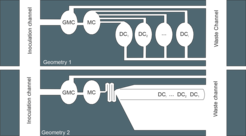
HAPPY Technology
We have invented an innovative microfluidic technology to track the replicative Lifespan in yeast. The device consists of a hierarchical trapping system whereby mother cells are firstly trapped in the microfluidic device allowing flow through of daughter cells. A series of hydrodynamic cell traps, placed in line with the outflow of the mother cell traps, allows the trapping of all the daughter cells from a single mother cell.
This method eradicates the need for online monitoring of the device, as the result could be determined with just a single image taken at the end of the experiment i.e. counting all the trapped daughter cells from a single mother cell.
We developed two designs that allow the sequential trapping of daughter cells. Both geometries are patent protected.
In geometry (1), a cell of unknown age (Grandmother cell “GMC”) is fixated in a trap. The first offspring of the GMCs are directed into an adjacent chamber and trapped there, while all other offspring of the GMCs are removed from the chip. The offspring of the trapped virgin cell (Mother cell “MC”) is trapped in separate chambers. The geometry of the chambers only allows one cell (Daughter cell “DC”) to enter each chamber, while the next cell will be directed to the next free chamber by increasing hydrodynamic resistance.
In geometry (2), the trapping of GMC and MC is performed according to geometry (1). In contrast to (1), the offspring of MCs will be trapped in a channel that is formed by square-shaped, rectangular, round-shaped, or oval structures (“pillars”). The free space between the pillars is big enough for the offspring of the daughter cells to be removed but too small for the daughter cells to pass through.

Disruptive Technology
Our chip design fundamentally differs from published approaches in one major aspect:
Due to the hierarchic design of the chip, the RLS of a single yeast cell can be deduced via a simple counting of the total number of daughter cells trapped simultaneously to the trapping and cultivation of a mother cell.
Access to a high-resolution microscope, the ability to take and analyze videos of dividing cells, or the capability to store the huge amount of data connected to microscopic studies, is reduced to a single time point snapshot using a standard digital camera with a minimal enlargement factor of 200, as e.g. given in many modern smartphones already.
